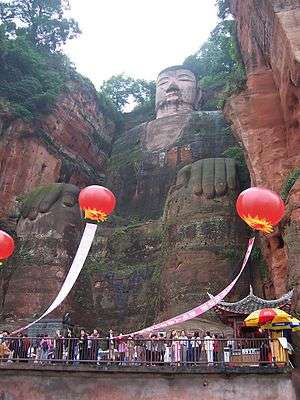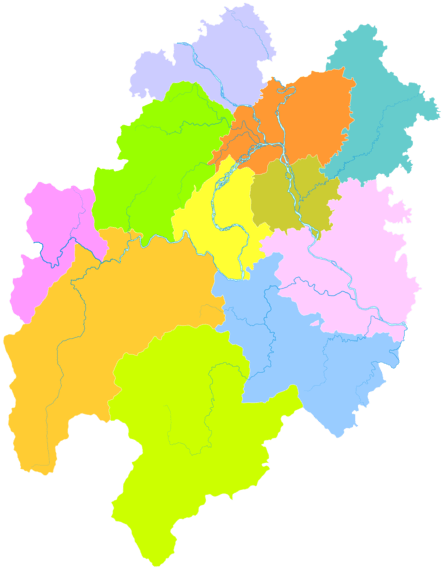Leshan
Leshan, formerly known as Jiading[lower-alpha 1] or Jiazhou, is a prefecture-level city located at the confluence of the Dadu and Min rivers in Sichuan Province, China. Leshan is located on the southwestern fringe of the Sichuan Basin in southern Sichuan, about 120 km (75 mi) from Chengdu. As of the 2010 census, its population was 3,235,759, of whom 662,814 lived in the built-up (or metro) area made of Shizhong district, as Wutongqiao and Jinkouhe districts are not conurbated yet.
Leshan 乐山市 | |
|---|---|
A view of Leshan | |
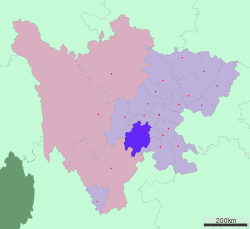 Location of Leshan City jurisdiction in Sichuan | |
| Coordinates (Leshan municipal government): 29°33′07″N 103°45′58″E | |
| Country | People's Republic of China |
| Province | Sichuan |
| County-level divisions | 4 Counties, 2 Autonomous Counties, 1 County-level city and 4 Districts |
| Municipal seat | Shizhong District |
| Area | |
| • Prefecture-level city | 12,827.49 km2 (4,952.72 sq mi) |
| • Urban | 1,918.5 km2 (740.7 sq mi) |
| • Metro | 836.1 km2 (322.8 sq mi) |
| Population (2010 census)[1] | |
| • Prefecture-level city | 3,235,759 |
| • Density | 250/km2 (650/sq mi) |
| • Urban | 1,162,080 |
| • Urban density | 610/km2 (1,600/sq mi) |
| • Metro | 662,814 |
| • Metro density | 790/km2 (2,100/sq mi) |
| Time zone | UTC+8 (China Standard) |
| Postal code | 614000 |
| Area code(s) | 0833 |
| ISO 3166 code | CN-SC-11 |
| Licence Plate Prefixes | 川L |
| Website | leshan |
| Leshan | |||||||||||||||||||||||
|---|---|---|---|---|---|---|---|---|---|---|---|---|---|---|---|---|---|---|---|---|---|---|---|
.svg.png) "Leshan" in Simplified (top) and Traditional (bottom) Chinese characters | |||||||||||||||||||||||
| Simplified Chinese | 乐山 | ||||||||||||||||||||||
| Traditional Chinese | 樂山 | ||||||||||||||||||||||
| |||||||||||||||||||||||
| Jiading | |||||||||||||||||||||||
| Chinese | 嘉定 | ||||||||||||||||||||||
| |||||||||||||||||||||||
History
The area of present day Leshan was the seat of historical Jiading city,[3] which the historical Jiading city covered not entirely the same area with modern day Leshan city. Some of the area of Leshan county, was ceded to Emeishan city in 1958.[3] In 1978, Leshan as a county-level city was formed.[3] In 1985, the Leshan prefecture-level city was formed, which Emeishan and other county level cities were under the administration of Leshan.[4] Before 1978, Leshan county-level city had Shizhong (means city centre), Wutongqiao (literally 5-"tong"-bridge) and Shawan (literally sand bay) three districts.[4] The establishment of Leshan prefecture-level city, also saw the disestablishment of Leshan Dìqū, an administrative area that supervisee Leshan, as well as other county-level cities and counties.[4]
Xinchang town, Jiading city [sic], was known for late Qing uprising against the government.[5]
Culture
Tourist attractions

In 1996, the Mount Emei Scenic Area, including the Leshan Giant Buddha, the largest stone-carved buddha in the world, which was declared a World Heritage Site by UNESCO. Next door to the Leshan Giant Buddha is the Oriental Buddha Park, a privately run cultural theme park, featuring thousands of reproductions of Buddha statues and Buddhist themed carvings.
Mount Emei is located within the county-level city of Emeishan, which is under the administrative jurisdiction of Leshan.
The ancestral home of Chinese writer, academic and politician Guo Moruo is preserved in the Shawan District of Leshan.[6]
Dialect
The Leshan dialect, part of the Southern linguistic system, is very different from the dialects of other cities in the province of Sichuan, which belong to the Northern system. Some researchers say the pronunciation of Leshan dialect represents an archaic form of Chinese pronunciation.
Food
Falling into the Sichuan cuisine family, Leshan is noted for its food culture in that it has all the street food from its surrounding areas, which has made it the one-stop street food city. Typical specialties include:
- Malatang (麻辣烫) - Hot and spicy soup
- Boboji (钵钵鸡) - Bobo chicken
- Shaokao (烧烤) - Street barbecue
- Qianwei Baobing (犍为薄饼) - Qianwei Pancakes
- Doufunao (豆腐脑) -Leshan Stlye DouFu Soup
- Tianpiya (甜皮鸭) - Sweet-Skinned Duck
- Qiaojiao Niurou (翘脚牛肉) Leshan Style Beef Hotpot
- Xiba Doufu (西坝豆腐) Xiba Tofu[7]
Transport
There are Chengdu–Mianyang–Leshan intercity railway and Chengdu–Guiyang high-speed railway serving Leshan.
The Chengdu-Leshan Freeway with a total length of 160 kilometers, was finished on January 14, 2000. This Freeway has since become very important to the city's development.
Education
Leshan Normal University (乐山师范学院) and Leshan Vocational & Technical College (乐山职业技术学院) are two government-fund colleges in the city.
Administrative divisions
| Map | |||||
|---|---|---|---|---|---|
| Name | Hanzi | Hanyu Pinyin | Population (2010) |
Area (km²) | Density (/km²) |
| Shizhong District | 市中区 | Shìzhōng Qū | 662,812 | 825 | 803 |
| Shawan District | 沙湾区 | Shāwān Qū | 187,180 | 617 | 303 |
| Wutongqiao District | 五通桥区 | Wǔtōngqiáo Qū | 312,086 | 474 | 658 |
| Jinkouhe District | 金口河区 | Jīnkǒuhé Qū | 49,157 | 598 | 82 |
| Emeishan City | 峨眉山市 | Éméishān Shì | 437,068 | 1,168 | 374 |
| Qianwei County | 犍为县 | Qiánwéi Xiàn | 434,409 | 1,375 | 316 |
| Jingyan County | 井研县 | Jǐngyán Xiàn | 282,222 | 841 | 336 |
| Jiajiang County | 夹江县 | Jiājiāng Xiàn | 338,345 | 749 | 451 |
| Muchuan County | 沐川县 | Mùchuān Xiàn | 216,737 | 1,401 | 154 |
| Ebian Yi Autonomous County | 峨边彝族自治县 | Ébiān Yízú Zìzhìxiàn |
139,210 | 2,395 | 58 |
| Mabian Yi Autonomous County | 马边彝族自治县 | Mǎbiān Yízú Zìzhìxiàn |
176,530 | 2,383 | 74 |
Geography and climate
Leshan has a monsoon-influenced humid subtropical climate (Köppen Cwa) and is largely mild and humid. Winter is short, mild and dry, with a January average of 7.2 °C (45.0 °F), and while frost may occur, snow is rare. Summers are long, hot and humid, with highs often exceeding 30 °C (86 °F), yet extended heat waves are rare. The daily average in July and August is around 26 °C (79 °F). Rainfall is light in winter and can be heavy in summer, and more than 70% of the annual total occurs from June to September.
| Climate data for Leshan (1981−2010) | |||||||||||||
|---|---|---|---|---|---|---|---|---|---|---|---|---|---|
| Month | Jan | Feb | Mar | Apr | May | Jun | Jul | Aug | Sep | Oct | Nov | Dec | Year |
| Record high °C (°F) | 19.3 (66.7) |
23.9 (75.0) |
32.5 (90.5) |
33.8 (92.8) |
36.5 (97.7) |
36.8 (98.2) |
37.6 (99.7) |
39.7 (103.5) |
36.3 (97.3) |
30.1 (86.2) |
25.7 (78.3) |
19.3 (66.7) |
39.7 (103.5) |
| Average high °C (°F) | 10.1 (50.2) |
12.6 (54.7) |
17.3 (63.1) |
22.8 (73.0) |
27.0 (80.6) |
28.6 (83.5) |
30.7 (87.3) |
30.4 (86.7) |
26.2 (79.2) |
21.2 (70.2) |
16.9 (62.4) |
11.3 (52.3) |
21.3 (70.3) |
| Daily mean °C (°F) | 7.2 (45.0) |
9.4 (48.9) |
13.1 (55.6) |
18.1 (64.6) |
22.1 (71.8) |
24.1 (75.4) |
26.2 (79.2) |
25.8 (78.4) |
22.3 (72.1) |
17.9 (64.2) |
13.7 (56.7) |
8.6 (47.5) |
17.4 (63.3) |
| Average low °C (°F) | 5.1 (41.2) |
7.0 (44.6) |
10.2 (50.4) |
14.6 (58.3) |
18.6 (65.5) |
21.0 (69.8) |
22.9 (73.2) |
22.5 (72.5) |
19.7 (67.5) |
15.8 (60.4) |
11.5 (52.7) |
6.7 (44.1) |
14.6 (58.4) |
| Record low °C (°F) | −1.4 (29.5) |
0.1 (32.2) |
0.2 (32.4) |
6.0 (42.8) |
10.5 (50.9) |
15.4 (59.7) |
18.5 (65.3) |
17.3 (63.1) |
13.6 (56.5) |
5.3 (41.5) |
2.2 (36.0) |
−1.9 (28.6) |
−1.9 (28.6) |
| Average precipitation mm (inches) | 14.8 (0.58) |
24.0 (0.94) |
43.3 (1.70) |
87.0 (3.43) |
98.5 (3.88) |
153.5 (6.04) |
265.1 (10.44) |
294.7 (11.60) |
149.5 (5.89) |
58.0 (2.28) |
31.3 (1.23) |
11.8 (0.46) |
1,231.5 (48.47) |
| Average precipitation days (≥ 0.1 mm) | 9.8 | 11.8 | 13.3 | 14.7 | 16.1 | 16.8 | 16.4 | 15.2 | 17.6 | 16.2 | 10.5 | 9.2 | 167.6 |
| Average relative humidity (%) | 82 | 79 | 76 | 74 | 73 | 79 | 81 | 81 | 83 | 84 | 82 | 83 | 80 |
| Source 1: China Meteorological Data Service Center[8] | |||||||||||||
| Source 2: Weather China (precipitation days 1971–2000) | |||||||||||||
Gallery
- Leshan
- Night view
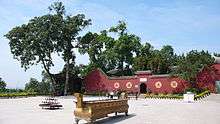 Buddhist temple
Buddhist temple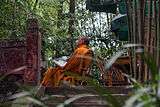 Buddhist Monk in Leshan
Buddhist Monk in Leshan Lingbao Pagoda
Lingbao Pagoda
Sister cities
.svg.png)


See also
References
- http://www.citypopulation.de/php/china-sichuan-admin.php
- EB (1878), Vol. V, "China".
- 乐山老县名考(十):乐山县. 三江都市报 (in Chinese). 18 May 2013. Retrieved 11 March 2019.
- 國務院關於同意四川省撤銷樂山地區實行市管縣給四川省人民政府的批覆 (PDF) (in Chinese). 1985 (10). State Council. 20 April 1985: 286. Retrieved 11 March 2019. Cite journal requires
|journal=(help) - Prazniak, Roxann (1999). "Weiyuan, Sichuan: Heaven-Protected Liu Xiangting among the Red Lanterns". Of Camel Kings and Other Things: Rural Rebels Against Modernity in Late Imperial China. Lanham, Maryland: Rowman & Littlefield. p. 140. ISBN 0-8476-9007-5. Retrieved 11 March 2019 – via Google book preview.
- Leshan -- Home of World's Largest Stone Buddha Statue
- Leshan Cuisine
- 中国地面气候标准值月值(1981-2010) (in Chinese). China Meteorological Data Service Center. Retrieved 20 October 2018.
- 楽山市 [Leshan City]. Ichikawa City Government. Archived from the original on 2009-08-28. Retrieved 2016-03-02.
- City of Ichikawa: Leshan City Archived 2009-08-28 at the Wayback Machine
External links
| Wikimedia Commons has media related to Leshan. |

- Official Government Website
